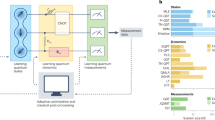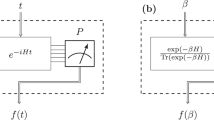Abstract
Learning the Hamiltonian that describes interactions in a quantum system is an important task in both condensed-matter physics and the verification of quantum technologies. Its classical analogue arises as a central problem in machine learning known as learning Boltzmann machines. Previously, the best known methods for quantum Hamiltonian learning with provable performance guarantees required a number of measurements that scaled exponentially with the number of particles. Here we prove that only a polynomial number of local measurements on the thermal state of a quantum system are necessary and sufficient for accurately learning its Hamiltonian. We achieve this by establishing that the absolute value of the finite-temperature free energy of quantum many-body systems is strongly convex with respect to the interaction coefficients. The framework introduced in our work provides a theoretical foundation for applying machine learning techniques to quantum Hamiltonian learning, achieving a long-sought goal in quantum statistical learning.
This is a preview of subscription content, access via your institution
Access options
Access Nature and 54 other Nature Portfolio journals
Get Nature+, our best-value online-access subscription
$29.99 / 30 days
cancel any time
Subscribe to this journal
Receive 12 print issues and online access
$209.00 per year
only $17.42 per issue
Buy this article
- Purchase on Springer Link
- Instant access to full article PDF
Prices may be subject to local taxes which are calculated during checkout



Similar content being viewed by others
Data availability
The data presented in the figures are available at https://github.com/gitmehdis/hamiltonian-learning.
Code availability
The codes used to generate the figures are available at https://github.com/gitmehdis/hamiltonian-learning.
References
Bernien, H. et al. Probing many-body dynamics on a 51-atom quantum simulator. Nature 551, 579–584 (2017).
Zhang, J. et al. Observation of a many-body dynamical phase transition with a 53-qubit quantum simulator. Nature 551, 601–604 (2017).
Arute, F. et al. Quantum supremacy using a programmable superconducting processor. Nature 574, 505–510 (2019).
Simon, J. et al. Quantum simulation of antiferromagnetic spin chains in an optical lattice. Nature 472, 307–312 (2011).
Brandao, F. G. S. L. & Svore, K. M. Quantum speed-ups for solving semidefinite programs. In Proc. 2017 IEEE 58th Annual Symposium on Foundations of Computer Science (FOCS) 415–426 (IEEE, 2017).
van Apeldoorn, J., Gilyén, A., Gribling, S. & de Wolf, R. Quantum SDP-solvers: better upper and lower bounds. Quantum 4, 230 (2020).
Brandão, F. G. S. L., Kueng, R. & França, D. S. Faster quantum and classical SDP approximations for quadratic binary optimization. Preprint at https://arxiv.org/abs/1909.04613 (2019).
Montanaro, A. Quantum speedup of Monte Carlo methods. Proc. R. Soc. A Math. Phys. Eng. Sci. 471, 20150301 (2015).
Harrow, A. W. & Wei, A. Y. Adaptive quantum simulated annealing for Bayesian inference and estimating partition functions. In Proc. Fourteenth Annual ACM-SIAM Symposium on Discrete Algorithms (ed. Chawla, S.) 193–212 (SIAM, 2020).
Wiebe, N., Kapoor, A. & Svore, K. M. Quantum deep learning. Quantum Inf. Comput. 16, 541–587 (2016).
Motta, M. et al. Determining eigenstates and thermal states on a quantum computer using quantum imaginary time evolution. Nat. Phys. 16, 205–210 (2020).
Wainwright, M. J. & Jordan, M. I. Graphical models, exponential families and variational inference. Found. Trends Mach. Learn. 1, 1–305 (2008).
Chow, C. & Liu, C. Approximating discrete probability distributions with dependence trees. IEEE Trans. Inf. Theory 14, 462–467 (1968).
Hinton, G. E. et al. Learning and relearning in Boltzmann machines. Parallel Distrib. Process. Explorations Microstruct. Cognition 1, 282–317 (1986).
Bresler, G. Efficiently learning Ising models on arbitrary graphs. In Proc. 2015 ACM Symposium on Theory of Computing 771–782 (ACM, 2015).
Klivans, A. R. & Meka, R. Learning graphical models using multiplicative weights. In Proc. 58th Annual IEEE Symposium on Foundations of Computer Science—FOCS 343–354 (IEEE, 2017).
Vuffray, M., Misra, S., Lokhov, A. & Chertkov, M. Interaction screening: efficient and sample-optimal learning of Ising models. In Advances in Neural Information Processing Systems (eds Lee, D. et al.) 2595–2603 (NIPS, 2016).
Bairey, E., Arad, I. & Lindner, N. H. Learning a local Hamiltonian from local measurements. Phys. Rev. Lett. 122, 020504 (2019).
Swingle, B. & Kim, I. H. Reconstructing quantum states from local data. Phys. Rev. Lett. 113, 260501 (2014).
Qi, X.-L. & Ranard, D. Determining a local Hamiltonian from a single eigenstate. Quantum 3, 159 (2019).
Wang, J. et al. Experimental quantum Hamiltonian learning. Nat. Phys. 13, 551–555 (2017).
Senko, C. et al. Coherent imaging spectroscopy of a quantum many-body spin system. Science 345, 430–433 (2014).
Evans, T. J., Harper, R. & Flammia, S. T. Scalable bayesian Hamiltonian learning. Preprint at https://arxiv.org/abs/1912.07636 (2019).
Bairey, E., Guo, C., Poletti, D., Lindner, N. H. & Arad, I. Learning the dynamics of open quantum systems from their steady states. New J. Phys. 22, 032001 (2020).
Shabani, A., Mohseni, M., Lloyd, S., Kosut, R. L. & Rabitz, H. Estimation of many-body quantum Hamiltonians via compressive sensing. Phys. Rev. A 84, 012107 (2011).
Wiebe, N., Granade, C., Ferrie, C. & Cory, D. G. Hamiltonian learning and certification using quantum resources. Phys. Rev. Lett. 112, 190501 (2014).
Wiebe, N., Granade, C., Ferrie, C. & Cory, D. Quantum Hamiltonian learning using imperfect quantum resources. Phys. Rev. A 89, 042314 (2014).
Leifer, M. S. & Poulin, D. Quantum graphical models and belief propagation. Ann. Phys. 323, 1899–1946 (2008).
Jaynes, E. T. On the rationale of maximum-entropy methods. Proc. IEEE 70, 939–952 (1982).
Jaynes, E. T. Information theory and statistical mechanics. Phys. Rev. 106, 620–630 (1957).
Cotler, J. & Wilczek, F. Quantum overlapping tomography. Phys. Rev. Lett. 124, 100401 (2020).
Bonet-Monroig, X., Babbush, R. & O’Brien, T. E. Nearly optimal measurement scheduling for partial tomography of quantum states. Phys. Rev. X 10, 031064 (2020).
Huang, H.-Y., Kueng, R. & Preskill, J. Predicting many properties of a quantum system from very few measurements. Nat. Phys. 16, 1050–1057 (2020).
Santhanam, N. P. & Wainwright, M. J. Information-theoretic limits of selecting binary graphical models in high dimensions. IEEE Trans. Inf. Theory 58, 4117–4134 (2012).
Montanari, A. Computational implications of reducing data to sufficient statistics. Electron. J. Stat. 9, 2370–2390 (2015).
Kuwahara, T., Kato, K. & L. Brandão, F. G. S. Clustering of conditional mutual information for quantum Gibbs states above a threshold temperature. Phys. Rev. Lett. 124, 220601 (2020).
Harrow, A. W., Mehraban, S. & Soleimanifar, M. Classical algorithms, correlation decay and complex zeros of partition functions of quantum many-body systems. In Proc. 52nd Annual ACM SIGACT Symposium on Theory of Computing (STOC) 378–386 (ACM, 2020).
Poulin, D. & Hastings, M. B. Markov entropy decomposition: a variational dual for quantum belief propagation. Phys. Rev. Lett. 106, 080403 (2011).
Ferris, A. J. & Poulin, D. Algorithms for the Markov entropy decomposition. Phys. Rev. B 87, 205126 (2013).
Verdon, G., Marks, J., Nanda, S., Leichenauer, S. & Hidary, J. Quantum Hamiltonian-based models and the variational quantum thermalizer algorithm. Preprint at https://arxiv.org/abs/1910.02071 (2019).
Wiebe, N. & Wossnig, L. Generative training of quantum Boltzmann machines with hidden units. Preprint at https://arxiv.org/abs/1905.09902 (2019).
G.S.L. Brandão, F. & Kastoryano, M. J. Finite correlation length implies efficient preparation of quantum thermal states. Commun. Math. Phys. 365, 1–16 (2019).
Brydges, T. Probing Rényi entanglement entropy via randomized measurements. Science 364, 260–263 (2019).
Harris, R. et al. Phase transitions in a programmable quantum spin glass simulator. Science 361, 162–165 (2018).
Acknowledgements
We thank A. Harrow, Y. Huang, R. La Placa, S. Subramanian, J. Wright and H. Yuen for helpful discussions. Part of this work was done when S.A. and T.K. were visiting Perimeter Institute. S.A. was supported in part by the Army Research Laboratory and the Army Research Office under grant no. W911NF-20-1-0014. The work was done when A.A. was affiliated to the Institute for Quantum Computing and Department of Combinatorics and Optimization, University of Waterloo and the Perimeter Institute for Theoretical Physics. A.A. was supported by the Canadian Institute for Advanced Research, through funding provided to the Institute for Quantum Computing by the Government of Canada and the Province of Ontario. Perimeter Institute is also supported in part by the Government of Canada and the Province of Ontario. T.K. was supported by the RIKEN Center for AIP and JSPS KAKENHI grant no. 18K13475. M.S. was supported by NSF grant no. CCF-1729369, a Samsung Advanced Institute of Technology Global Research Cluster and grant no. FXQi-RFP-1811A from the Foundational Questions Institute and Fetzer Franklin Fund, a donor advised fund of Silicon Valley Community Foundation.
Author information
Authors and Affiliations
Contributions
A.A., S.A., T.K. and M.S. contributed equally in developing the main ideas, technical aspects and the writing of this work. The authors are arranged alphabetically based on the last name.
Corresponding authors
Ethics declarations
Competing interests
The authors declare no competing interests.
Additional information
Peer review information Nature Physics thanks Vedran Dunjko and the other, anonymous, reviewer(s) for their contribution to the peer review of this work.
Publisher’s note Springer Nature remains neutral with regard to jurisdictional claims in published maps and institutional affiliations.
Supplementary information
Supplementary Information
Supplementary Figs. 1–3 and Discussion.
Rights and permissions
About this article
Cite this article
Anshu, A., Arunachalam, S., Kuwahara, T. et al. Sample-efficient learning of interacting quantum systems. Nat. Phys. 17, 931–935 (2021). https://doi.org/10.1038/s41567-021-01232-0
Received:
Accepted:
Published:
Issue Date:
DOI: https://doi.org/10.1038/s41567-021-01232-0
This article is cited by
-
Learning quantum Hamiltonians from high-temperature Gibbs states and real-time evolutions
Nature Physics (2024)
-
Practical Hamiltonian learning with unitary dynamics and Gibbs states
Nature Communications (2024)
-
Efficient and robust estimation of many-qubit Hamiltonians
Nature Communications (2024)
-
Efficient learning of many-body systems
Nature Physics (2024)
-
Effective light cone and digital quantum simulation of interacting bosons
Nature Communications (2024)



